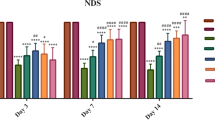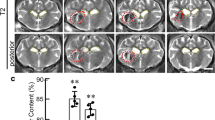Abstract
More and more studies have reported the usefulness of repetitive transcranial magnetic stimulation (rTMS) in the treatment of stroke patients. This article is to explore if rTMS can cause changes of such chemical substances as N-acetylaspartate (NAA), choline (Cho) and creatine (Cr) in the surrounding area of experimental intracerebral hematoma of rabbits. A total of 36 rabbits were randomly divided into 3 groups: a control group (group A), a sham rTMS group (group B) and an rTMS group (group C). The experimental intracerebral hemorrhage (ICH) was induced by intracerebral injection of selfbody blood of the animals in groups B and C, while those of the group A serving as controls were injected with normal saline. The rabbits of groups B and C were treated with sham and real rTMS, respectively, but those of group A were not. The contents of chemical substances including NAA, Cho and Cr in the perihematomal brain tissues were measured by using 1H-magnetic resonance spectroscopy (1H-MRS) 12 hours, 72 hours, 1 week and 2 weeks after the experimental ICH was induced. The results show that the contents of NAA, Cr and NAA/Cr ratio were decreased significantly, but Cho, Cho/Cr increased significantly in groups B and C (P < 0.01) as compared against those in group A. A comparison between the groups B and C revealed that the contents of NAA, Cr, NAA/Cr were higher, but Cho and Cho/Cr were significantly lower in group C than those in group B (P < 0.01). It is concluded that rTMS could result in changes of the chemical substance contents in perihematomal brain tissues, which leads to neuroprotective effects in the brain.
Similar content being viewed by others
References
Swayne O B C, Rothwell J C, Ward N S, Greenwood R J. Stages of motor output reorganization after hemispheric stroke suggested by longitudinal studies of cortical physiology. Cereb Cortex, 2008, 18(8): 1909–1922
Chen R, Cros D, Curra A, Di Lazzaro V, Lefaucheur J P, Magistris M R, Mills K, Rösler K M, Triggs W J, Ugawa Y, Ziemann U. The clinical diagnostic utility of transcranial magnetic stimulation: report of an IFCN committee. Clin Neurophysiol, 2008, 119(3): 504–532
Reis J, Swayne O B, Vandermeeren Y, Camus M, Dimyan M A, Harris-Love M, Perez M A, Ragert P, Rothwell J C, Cohen L G. Contribution of transcranial magnetic stimulation to the understanding of cortical mechanisms involved in motor control. J Physiol, 2008, 586(2): 325–351
O’Reardon J P, Solvason H B, Janicak P G, Sampson S, Isenberg K E, Nahas Z, McDonald W M, Avery D, Fitzgerald P B, Loo C, Demitrack M A, George M S, Sackeim H A. Efficacy and safety of transcranial magnetic stimulation in the acute treatment of major depression: a multisite randomized controlled trial. Biol Psychiatry, 2007, 62(11): 1208–1216
Kinoshita M, Ikeda A, Begum T, Yamamoto J, Hitomi T, Shibasaki H. Low-frequency repetitive transcranial magnetic stimulation for seizure suppression in patients with extratemporal lobe epilepsy: a pilot study. Seizure, 2005, 14(6): 387–392
Ikeguchi M, Touge T, Nishiyama Y, Takeuchi H, Kuriyama S, Ohkawa M. Effects of successive repetitive transcranial magnetic stimulation on motor performances and brain perfusion in idiopathic Parkinson’s disease. J Neurol Sci, 2003, 209(1–2): 41–46
Rollnik J D, Wüstefeld S, Däuper J, Karst M, Fink M, Kossev A, Dengler R. Repetitive transcranial magnetic stimulation for the treatment of chronic pain-a pilot study. Eur Neurol, 2002, 48(1): 6–10
Niu Z, Zhang T, Fang D. The effect of TMS on motor function in patients with acute brain infarction. Zhongguo Kangfu Lilun Yu Shijian, 2001, 7(1): 16–18 (in Chinese)
Jin X, Wu X, Wang J, Huang B, Wang Q, Zhang T, Niu Z, Zhang X. Effect of transcranial magnetic stimulation on rehabilitation of motor function in patients with cerebral infarction. Zhonghua Yi Xue Za Zhi, 2002, 82(8): 534–553 (in Chinese)
Zhao H, Sun Y, Dai Y. The effects of TMS on BDNF expression and infarct volume in rats with cerebral ischemia. Zhonghua Shenjingbingxue Zazhi, 2005, 38(5): 330–331 (in Chinese)
Sun Y, Zao H, Zhang Z, Huo H, Li W, Bao S. Effect of longterm transcranial magnetic stimulation on the expression of brain-derived neurotrophic factor in cortex around the infarcted focus and the recovery of neurologic function in rats with cerebral infarction. Zhonghua Wuli Yixue Yu Kangfu Zazhi, 2005, 27(12): 712–716 (in Chinese)
Wang T C, Guo T C, Zhu X L. An experimental study of the effect of rTMS on cerebral hemorrhage in rabbits. Zhonghua Wuli Yixue Yu Kangfu Zazhi, 2003, 25: 390–393 (in Chinese)
Guo T C, Cao X B, Zhang Y J, Sun S G, Zhu X L. Effect of rTMS on contents of monoamine and amino acid transmitters in rabbits with cerebral hemorrhage. Zhonghua Wuli Yixue Yu Kangfu Zazhi, 2004, 26(8): 452–455 (in Chinese)
Barker P B, Gillard J H, van Zijl P C, Soher B J, Hanley D F, Agildere A M, Oppenheimer S M, Bryan R N. Acute stroke: evaluation with serial proton MR spectroscopic imaging. Radiology, 1994, 192(3): 723–732
Auld K L, Ashwal S, Holshouser B A, Tomasi L G, Perkin R M, Ross B D, Hinshaw D B Jr. Proton magnetic resonance spectroscopy in children with acute central nervous system injury. Pediatr Neurol, 1995, 12(4): 323–334
Lanfermann H, Kugel H, Heindel W, Herholz K, Heiss W D, Lackner K. Metabolic changes in acute and subacute cerebral infarctions: findings at proton MR spectroscopic imaging. Radiology, 1995, 196(1): 203–210
Peng H, Li Y F, Sun S G. Effects of Ginkgo biloba extract on acute cerebral ischemia in rats analyzed by magnetic resonance spectroscopy. Acta Pharmacol Sin, 2003, 24(5): 467–471
Handa Y, Kaneko M, Matuda T, Kobayashi H, Kubota T. In vivo proton magnetic resonance spectroscopy for metabolic changes in brain during chronic cerebral vasospasm in primates. Neurosurgery, 1997, 40(4): 773–180
Kamada K. Sequential observations of brain edema with proton magnetic resonance imaging and spectroscopy. Hokkaido Igaku Zasshi, 1996, 71(1): 105–122
Ye C L, Yu M K, Jiang J Y, Zhang G J, Lu Y C, Zhu C. 1H Magnetic resonance spectroscopy analysis of frontal lobe in patients with traumatic brain injury. Zhonghua Yi Xue Za Zhi, 2003, 83(2): 140–141 (in Chinese)
Author information
Authors and Affiliations
Corresponding author
Rights and permissions
About this article
Cite this article
Guo, T., Cao, X. & Xia, L. Repetitive transcranial magnetic stimulation causes significant changes of chemical substances in the brain of rabbits with experimental intracerebral hemorrhage. Front. Med. China 2, 406–409 (2008). https://doi.org/10.1007/s11684-008-0078-y
Received:
Accepted:
Published:
Issue Date:
DOI: https://doi.org/10.1007/s11684-008-0078-y




